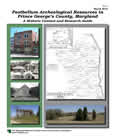Postbellum Archeological Resources in Prince George's County, Maryland A Historic Context and Research Guide

Title:
Postbellum Archeological Resources in Prince George's County, Maryland A Historic Context and Research Guide
Author:
The Maryland-National Capital Park and Planning Commission
Prince George's County Planning Department
Source of Copies:
The Maryland-National Capital Park and Planning Commission
14741 Governor Oden Bowie Drive
Upper Marlboro, MD 20772
Number of Pages:
210
Prince George’s County adopted subdivision regulations in 2005 that were intended to ensure that archeological sites deemed significant to understanding the history of human settlement in the county be identified as part of the subdivision review process. Historic sites dating to the late-nineteenth and early-twentieth centuries (circa 18651958) are one of the most common categories of resources identified in archeological surveys in the county, with over 300 examples in the Maryland Historical Trust (MHT) site files as of October 2007. However, additional investigations are being recommended at few, if any, of these sites. Still this time period witnessed many changes, including the subdivision of large plantations, significant changes in the relations of production, establishment of African-American-owned farms and communities, new technologies, transportation enhancements, and the growth of suburbia. Nevertheless, the contribution of the late-nineteenth and early-twentieth century archeological sites to the understanding of these changes in Prince George’s County is either unknown or unappreciated.
Related Documents:
 A Cover 1
A Cover 1
 Chapter 0 Table of Contents
Chapter 0 Table of Contents
 Chapter 01 Introduction
Chapter 01 Introduction
 Chapter 02 Geographic and Historical Overview
Chapter 02 Geographic and Historical Overview
 Chapter 03 Agriculture
Chapter 03 Agriculture
 Chapter 04 Industry and Services
Chapter 04 Industry and Services
 Chapter 05 Military Facilities
Chapter 05 Military Facilities
 Chapter 06 The African-American Experience
Chapter 06 The African-American Experience
 Chapter 07 Government Facilities
Chapter 07 Government Facilities
 Chapter 08 Transportation
Chapter 08 Transportation
 Chapter 09 Settlement
Chapter 09 Settlement
 Chapter 10 Registration Requirements
Chapter 10 Registration Requirements
 Chapter 11 References Cited
Chapter 11 References Cited
 Chapter 12 Appendix A
Chapter 12 Appendix A
 Chapter 13 Appendix B
Chapter 13 Appendix B
 Cover 3 Acknowledgements
Cover 3 Acknowledgements